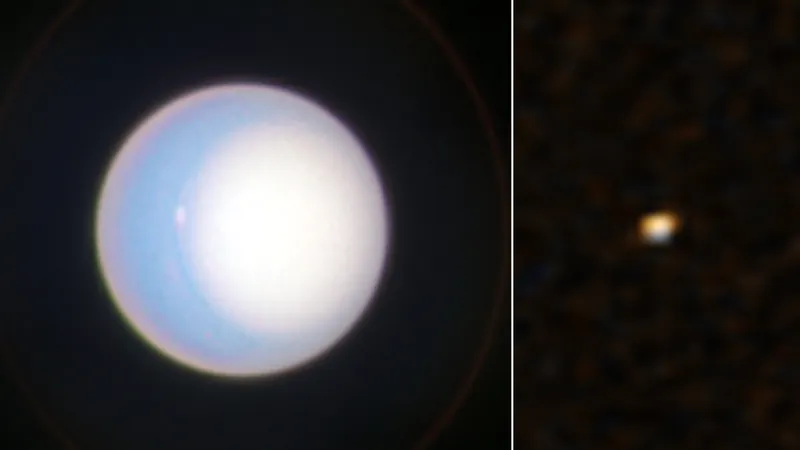
NASA's Epic Collaboration: Hubble and New Horizons Team Up to Reveal Secrets of Uranus!
2024-10-11
Author: Ling
NASA's Epic Collaboration: Hubble and New Horizons Team Up to Reveal Secrets of Uranus!
Two of NASA’s most iconic spacecraft have joined forces to unveil the mysteries of Uranus, the most enigmatic planet in our solar system! The Hubble Space Telescope and the New Horizons spacecraft, known for its groundbreaking flyby of Pluto, have teamed up to capture unparalleled direct images of this frosty giant.
While Hubble brought its high-resolution capabilities to the table, revealing intricate details of Uranus’ atmosphere, New Horizons offered a broader view, capturing the planet's image as a faint “blob” from over 6.5 billion miles away. This collaborative effort allows astronomers to compare perspectives, with Hubble giving insights into the atmospheric dynamics while New Horizons provides context that is crucial for understanding distant celestial bodies.
Uranus is a cold, icy giant, and although scientists have studied it to some extent, many questions remain unanswered. What’s truly exciting is that the findings from this two-pronged observation approach may guide future telescopes as they venture to image exoplanets. Direct imaging of exoplanets has proven incredibly challenging, yet this collaboration hopes to pave the way for future discoveries.
Samantha Hasler, a scientist at MIT involved in the New Horizons project, remarked that the dimness of Uranus in New Horizons data was unexpected. This variability in brightness highlights the need for refined observation techniques that can be tested on both Uranus and distant exoplanets.
Why Focus on Exoplanets?
Since the first exoplanet was discovered in the 1990s, astronomers have identified over 6,000 exoplanets, yet only a handful have been directly imaged. Most are detected through their transits across stars or by measuring the gravitational pull they exert. The challenge arises mainly from their immense distances—up to four light-years away for Proxima Centauri b, the nearest known exoplanet!
Direct imaging is crucial as it helps astronomers determine potential habitability and compare these worlds to our own solar system planets. Uranus serves as an ideal model because many exoplanets share its gas giant characteristics, allowing for comparative analyses.
During New Horizons’ observations, Hubble, orbiting near Earth, was able to capture atmospheric features like clouds and storms on the sunlit side of Uranus. Hasler noted the intriguing characteristic of Uranus appearing as a mere dot in New Horizons’ images, much like how directly imaged exoplanets appear from great distances. Hubble’s detailed observations help contextualize atmospheric phenomena detected by New Horizons.
A Bright Future for Space Exploration!
The collaboration aims to address whether exoplanets have cloud patterns akin to those found on gas giants like Jupiter and Saturn. By utilizing Hubble’s detailed cloud observations, the team verified New Horizons' findings, revealing that Uranus’ brightness remained stable across its rotation—implying minimal changes in its cloud features.
This innovative approach not only enriches our understanding of Uranus but also prepares the groundwork for NASA's upcoming missions. The Nancy Grace Roman Space Telescope, set to launch in 2027, will utilize advanced techniques to block stellar light and focus on exoplanets, enhancing our observational capabilities. Furthermore, the anticipated Habitable Worlds Observatory will specifically target biosignatures around rocky planets, propelling our search for extraterrestrial life.
As Hasler concluded, the insights from Uranus will empower future missions, building robust expectations and crafting a promising roadmap for interstellar explorations.
This unprecedented collaboration between Hubble and New Horizons is just the beginning. Stay tuned for more discoveries that will push the boundaries of our understanding of the cosmos!




 Brasil (PT)
Brasil (PT)
 Canada (EN)
Canada (EN)
 Chile (ES)
Chile (ES)
 España (ES)
España (ES)
 France (FR)
France (FR)
 Hong Kong (EN)
Hong Kong (EN)
 Italia (IT)
Italia (IT)
 日本 (JA)
日本 (JA)
 Magyarország (HU)
Magyarország (HU)
 Norge (NO)
Norge (NO)
 Polska (PL)
Polska (PL)
 Schweiz (DE)
Schweiz (DE)
 Singapore (EN)
Singapore (EN)
 Sverige (SV)
Sverige (SV)
 Suomi (FI)
Suomi (FI)
 Türkiye (TR)
Türkiye (TR)